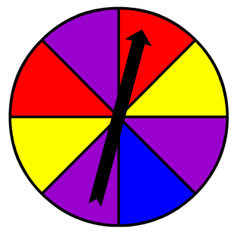In this section, you will use a spinner simulator to conduct several "spins" in order to compare theoretical probabilities with experimental probabilities.
![]()
Use the "Spinner" below which has three equal-sized sections that are blue, red, and yellow.
Color |
Number of Spins |
Red |
|
Yellow |
|
Blue |
Assume that the areas of each sector of the spinner are the same.
What is the theoretical probability of the spinner landing on each color?
Interactive popup. Assistance may be required. Since there is only one sector in each color (red, blue, and yellow), the probability of the spinner landing on each color is 1 over 3 1 3 .
Based on the theoretical probability of the spinner landing on each color, how many spins out of 30 spins should land on each color?
Interactive popup. Assistance may be required. What is 1 over 3 1 3 of 30 spins? Interactive popup. Assistance may be required.
There should be 10 spins of each color.
Interactive popup. Assistance may be required.
There should be 10 spins of each color.
Did the actual results of the spins match the results predicted by theoretical probability? Why do you think that is the case?
Interactive popup. Assistance may be required. Your answer may vary. Usually, actual results are close to, but not exactly like, what theoretical probability indicates should happen.
![]()
Repeat the process with the same spinner for a total of 100 spins.
Based on the theoretical probability of the spinner landing on each color, how many spins out of 100 spins should land on each color?
Interactive popup. Assistance may be required. What is 1 over 3 1 3 of 100 spins? Interactive popup. Assistance may be required.
There should be 33 spins of each color.
Interactive popup. Assistance may be required.
There should be 33 spins of each color.
Did the actual results of the spins match the results predicted by theoretical probability? Why do you think that is the case?
Interactive popup. Assistance may be required. Your answer may vary. Usually, the actual results are close to, but not always the same as, what is predicted by theoretical probability. This phenomenon is called the Law of Large Numbers.
Consider the spinner that is shown.

Interactive popup. Assistance may be required.
The theoretical probability of the spinner landing on any given color is equal to the ratio: Interactive popup. Assistance may be required.
P(red) = 2 over 8
2
8
= 1 over 4
1
4
Interactive popup. Assistance may be required.
P(red) = 2 over 8
2
8
= 1 over 4
1
4

Kazumi spun the spinner 40 times, and recorded her results in the table.
|
Results of Kazumi's Spins
|
|
|
Color
|
Number of Spins
|
|
Red
|
12
|
|
Purple
|
16
|
|
Yellow
|
8
|
|
Blue
|
4
|
Use the grid below to record your answer. Type your answer in the boxes in front of and behind the decimal. Click inside each box to enter the numeral that belongs in the box, and then click the bubble beneath the numeral to shade the bubble that matches the numeral. After hitting the "Submit" button, incorrect portions of your answer will be shaded gray.
![]()
Interactive popup. Assistance may be required.
P = Number of Spaces of Desired Color over Number of Total Spaces Number of Actual Desired Spins Number of Total Spins Interactive popup. Assistance may be required.
30%
Interactive popup. Assistance may be required.
30%

